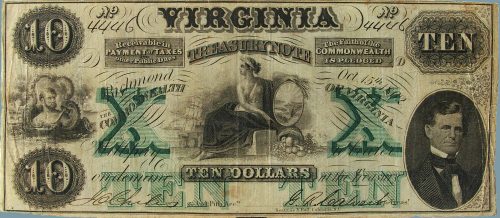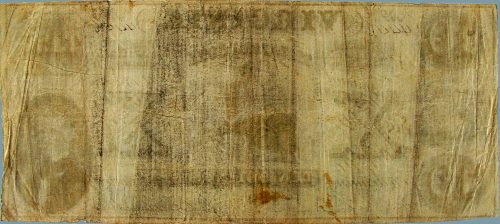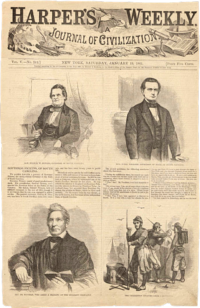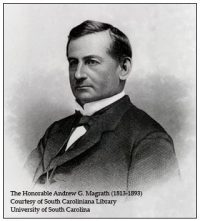P032
Civil War Confederate Paper Currency, Fine, Plate D, No. 4446
193 mm x 80 mm (7-9/16” x 3-3/16”)
HISTORY: Prior to the secession of Virginia from the Union, ratified May 23, 1861, Virginia had been contracting with the American Bank Note Company (ABNC) in New York City for the engraving and printing of their banknotes. The ABNC had only been in business since 1858, following the merger of a number of independent engravers.
To digress briefly, an engraver by the name of Freeman Rawdon (1802‒1859) opened a banknote business in New York City in 1825. Three years later, in 1828, he teamed with Neziah Wright (1804‒1879) as business expanded. In 1832, Rawdon’s older brother Ralph Rawdon (1790‒1860) and his partners joined the enterprise, which now became the Rawdon, Wright, Hatch & Co. New York. By 1847, they had added Tracy Edson (1809‒1881), primarily as business administrator, to run operations in New Orleans, Boston, and eventually New York. His name was added to the letterhead, known prominently as Rawdon, Wright, Hatch & Edson (RWH&E). Before the beginning of the War Between the States (the American Civil War), in 1958, the firm merged with seven smaller engraving companies to become the ABNC, New York City. Their library of engraved “clip art” plates now spanned back decades to the 1820s.
Edward Keatinge (1817‒1867), a portrait engraver (and a British citizen), had been working for the ABNC, and his skills were highly regarded. Following Virginia’s secession, Keatinge was lured by the confederate Treasury Department to ply his trade in Richmond and continue designing currency for the Commonwealth of Virginia. He accepted and was teamed with a Virginian lawyer, Thomas A. Ball. Together they set up a business in Richmond as Keatinge & Ball. Richmond, however, soon became a hot spot in the intense War Between the States, so they relocated to Columbia, South Carolina, taking with them the equipment and supplies that had been smuggled through the lines of the Union blockade. They continued production of currency for the Commonwealth of Virginia as required until the company, Keatinge & Ball Columbia S.C., was destroyed in February 1865 by the Union Army’s General William Sherman (1820–1891).
OBVERSE: Keatinge was a master portraitist with a fine though dark style. As the storm of war swirled around them, even at their very doors, they gave us a vignette of Thor, the hammer-wielding protector, god of thunder, storm, and strength. Behind Thor is a raging sea battle, smoke rising. This vignette, however, was taken from the ABNC (or more likely RWH&E) library of images, which implies that Keatinge brought engraving plates with him when he left New York. The centerpiece, also a possible pilfered plate vignette, is a graceful image of Ceres, goddess of agriculture, grains, and fertility. She is crowned with a wreath while holding a shield to her left, illustrating a sheaf of wheat and a plough against the backdrop of a rising sun on the horizon of the Atlantic Ocean. In her left hand, she grasps shafts of a variety of cereals, while below, a cornucopia spews an abundance of fruits and vegetables. To her right is a bustling shipping port.
This “TEN DOLLAR” Virginia Treasury note (“Richmond, Oct. 15th 1862” No. 4446), however, features a Keatinge portrait of South Carolina leader, Andrew Gordon Magrath (1813‒1893). Magrath served as Secretary of State of South Carolina from November 1860 to April 1861. Educated at Harvard Law School, Magrath was elevated to the bench in May 1861 where he served as a judge until December 1864. He then became the last confederate governor, serving until the end of the war in May 1865.
At the bottom of this note, beneath the original signature of the treasurer (or authorized representative), is the engraver’s identification “Keatinge & Ball . Columbia . S.C.”
REVERSE: Blank (no watermark).




